哈希表(Hashtable )
类代表了一系列基于键的哈希代码组织起来的键/值对。它使用键来访问集合中的元素。当您使用键访问元素时,则使用哈希表,而且您可以识别一个有用的键值。哈希表中的每一项都有一个键/值对。键用于访问集合中的项目。
API
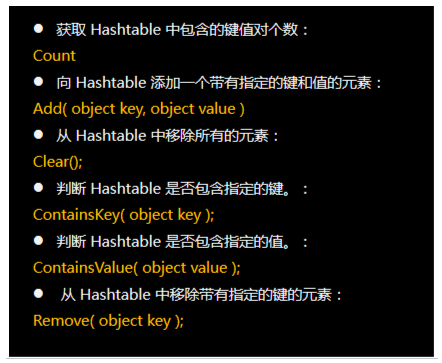
Hashtable hash = new Hashtable(); hash.Add(1, "first"); //添加键值对 hash.Add(false, 123); hash.Add("str", true); int count = hash.Count; //获取哈希表中包含元素的个数 bool isHaveKey = hash.ContainsKey(1); //判断哈希表是否包含指定的键 bool isHaveKey2 = hash.Contains(2); //同样判断键 bool isHaveValue = hash.ContainsValue(123); //判断是否含有指定的值 ICollection keys = hash.Keys; //获取哈希表所有的键 foreach (var item in keys) { Console.WriteLine(item); //遍历键名 } Console.WriteLine("--------------"); ICollection values = hash.Values; //获取哈希表所有的值 foreach (var item in values) { Console.WriteLine(item); } hash.Remove(1); //按照指定索引删除相对应的元素 Console.WriteLine("---------------"); foreach (DictionaryEntry item in hash) //遍历哈希表键值对 { Console.WriteLine(item.Key); Console.WriteLine(item.Value); } bool isSize = hash.IsFixedSize; //获取一个值表示是否有固定大小 bool isRead = hash.IsReadOnly; //判断哈希表是否只读 Console.WriteLine("************"); Console.WriteLine(isRead); hash.Clear(); //清空哈希表
哈希表和字典的区别

栈
概念
堆栈(Stack)代表了一个先进后出的对象集合,当需要对各项进行先进后出的访问时,则使用堆栈
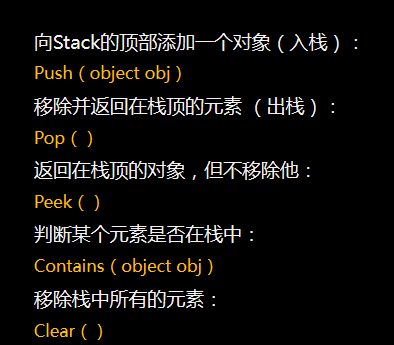
泛型栈
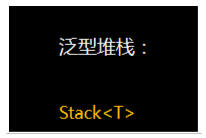
队列
概念
队列(Queue)代表了一个先进先出的对象集合,当需要对各项进行先进先出的访问时,则使用队列
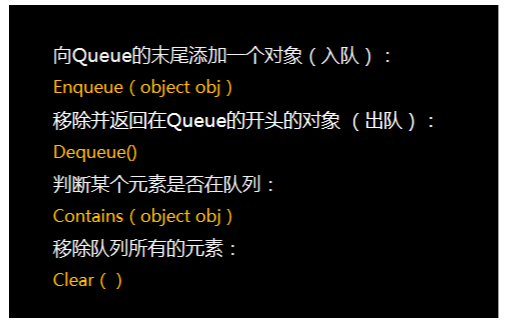
链表

优缺点
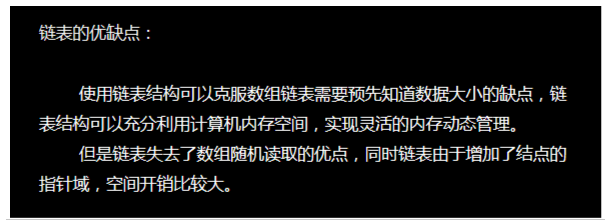
链表分类
单向链表
当前每一个节点只存储指向下一个节点的地址
双向链表
每一个节点中存储前一个节点的地址和后一个节点的地址
环形链表
头尾连接
链表分为两部分
节点类
数据
指向(指针域):下一个节点/前一个节点
class Node<T> { private T data; //数据 private Node<T> next; //指针 public Node(Node<T> next) { this.next = next; //首节点 只有指针没有值 } public Node(T data) { this.data = data; //尾结点 只有值没有指针 } public Node(T data, Node<T> next) //中间各节点 { this.Data = data; this.Next = next; } public Node() //无参构造 { this.data = default(T); this.next = null; } public T Data { get { return data; } set { data = value; } } internal Node<T> Next { get { return next; } set { next = value; } } }
链表类
头节点
class LinkList<T> { private Node<T> first; internal Node<T> First { get { return first; } set { first = value; } } public LinkList() { this.First = null; } public void Add(T data) { Node<T> node = new Node<T>(data);//先创建一个节点,数据传进去 Node<T> tmp = new Node<T>() ; //如果首节点不为空 定义临时节点 if (first == null) { first = node; //如果首节点是空,则把值赋给首节点 return; } tmp = first; while (tmp.Next!=null) { tmp = tmp.Next; //让临时节点不断的指向下个节点,直到下个节点为空,那么这个节点则是最后一个节点 } tmp.Next = node; //把带有数据的节点赋值给最后一个节点的next } public int GetLength() //链表长度 { int index = 0; Node<T> tmp = first; while(tmp != null) { index++; tmp = tmp.Next; } return index; } public void DisPlay() //显示链表数据 { Node<T> tmp = first; while(tmp!=null) { Console.Write(tmp.Data + " "); tmp = tmp.Next; } } public bool IsEmpty() //判断链表是否为空 { if(first==null) { return true; } else { return false; } } public void Insert(int index, T data) { Node<T> node = new Node<T>(data); if (index < 0 || index>GetLength()||IsEmpty()) { throw new Exception("数组越界"); } else if(index==0) //索引为0时,把数据的next指向首节点, { node.Next = first; first = node; } else if(index==GetLength()) //索引跟链表长度一致时,就是添加数据 { Add(data); } else { int count = 0; Node<T> p = first; Node<T> tmp = new Node<T>(); while(count!=index) { count++; tmp = p; //把首节点给tmp p = p.Next; //把p的下一个节点给p 此时关系是 tmp p tmp在p前面 } if (index == count) //如果到了索引的位置,则开始把数据放到tmp和p的中间 { tmp.Next = node; node.Next = p; } } } //查找链表第i个数据 public T GetValue(int index) { int count = 0; if(index<0||IsEmpty()||index>GetLength()) { throw new Exception("数组越界"); }else { Node<T> tmp = first; while(count!=index) //循环直到给定的索引值 { count++; tmp = tmp.Next; } return tmp.Data; //把数值return出去 } } //删除第i个元素 public T Delete(int index) { int count = 0; if (index < 0 || IsEmpty() || index > GetLength()) { throw new Exception("数组越界"); } else { if(index==0) { T data = first.Data; //首节点的值抛出 first = first.Next; //首节点指向下一个指针指向首节点 return data; } else { Node<T> p = first; Node<T> tmp = new Node<T>(); while (count != index) //循环直到给定的索引值 { count++; tmp = p; //p节点赋值给临时节点 此时顺序为tmp p p = p.Next; } if(count == index) { tmp.Next = p.Next; //把tmp的指针直接指向p的下一个指针,断开了tmp原本的下一个指针 return p.Data; } } return default(T); } } }